A Thousand Years of History in Jerusalem’s Jewish Quarter
A walking tour reveals Jerusalem flourishing, destroyed and splendidly rebuilt.
022
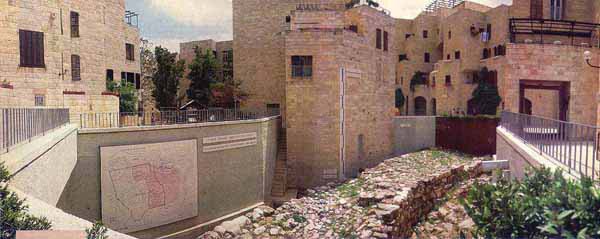
023
War—or rather two wars—made possible the current golden age of discovery in Jerusalem, at the City of David, at the Temple Mount and in the Old City’s Jewish Quarter. In 1948, during Israel’s War of Independence, the occupants of the Jewish Quarter surrendered to the Arab Legion following a long siege. Some houses had been damaged in battle, but most of the destruction occurred when the Arabs dynamited the Quarter’s institutions—synagogues, yeshivas (religious schools) and hospitals—after the surrender. For 19 years the Quarter stood empty and silent.
Then, in June 1967, the Six-Day War brought the whole of Jerusalem under Jewish control once again—for the first time since 02470 C.E.,a when the Romans had conquered and burned the city. This opened up undreamt of opportunities to explore Jerusalem.1 The government took title to all the land and buildings in the Jewish Quarter, with the exception of Muslim holy places, and formed the Company for the Reconstruction and Development of the Jewish Quarter. The Old City was declared a protected antiquities zone where no new construction could take place until archaeologists had examined the proposed building sites.b Since 1967 the Jewish Quarter has been rebuilt and repaired, but only after archaeological approval.
In 1967, Professor Nahman Avigad of Hebrew University, then 62, was planning to take a sabbatical abroad and soon thereafter to retire. Instead he was persuaded to become director of the Jewish Quarter Excavations. An extraordinary opportunity to excavate was now matched with an extraordinary archaeologist. Avigad brought to his task breadth of knowledge, years of experience in the field and a vision of the future that the challenge demanded.
Excavations began in 1969. In archaeology, a year usually means a season, or a summer, of actual digging. But in Jerusalem the archaeologists were under pressure from builders to complete their work so that housing construction could start. Avigad and his team dug nonstop for 14 years, during eight, ten and sometimes twelve months each year. They even worked in the rain, under plastic sheets. After the sites were documented, the builders took over, sometimes raising a building above an ancient structure that would one day emerge again into public view.
From the very start, Avigad began to think of ways to preserve his discoveries. He meticulously supervised the preservation and restoration work at each site and prepared the ancient remains so they could be understood and imagined as they once were.c
Now the huge building cranes are gone. So are the donkeys that carried tons of debris out of the digs. The Quarter teems with life. At the central Hurva Square, schoolchildren play ball, housewives carry home baskets full of goods and tourists eat pizza under striped umbrellas amidst ancient grinding stones, column bases and sections of Roman aqueducts arrayed in the plaza.
The following “walk” through the Jewish Quarter includes five restored sites, now integrated into the fabric of the living city. Although the remains are situated within a quarter of a square mile, some sites are located deep below street level, so there will be hundreds of stairs to climb. But visitors won’t be bothered by cars: they’re banned from most of the Old City and the alleys are too narrow for cars to enter anyway.2
Let’s start with a 1:250 scale model of Jerusalem at the end of the First Temple period. The model, located at the Rachel Yanait Ben-Zvi Center on Plugat HaKotel Road, will help us visualize Jerusalem’s hills and valleys and how the topography relates to the remains we will see.d
Jerusalem is a city on two hills—a western hill sometimes called in its entirety Mt. Zion and an eastern hill called Mt. Moriah, or the Temple Mount—separated by the Tyropoeon Valley. The City of David, with its life-giving spring Gihon, is at the 026southern extension of the eastern hill and is the oldest part of Jerusalem. The northern part is where Solomon built his Temple and where, almost 1,000 years later, the Temple and its platform were enlarged into a magnificent structure by Herod the Great.e The western hill includes the Citadel at Jaffa Gate and the areas today called the Armenian Quarter, the Jewish Quarter and Mt. Zion, the area on the southwestern side of the hill.
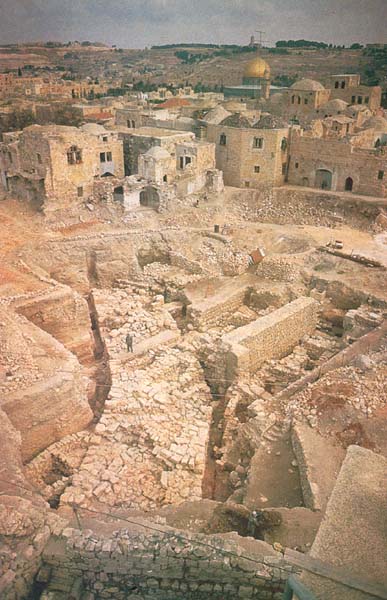
Our first two destinations in the Jewish Quarter date to before 586 B.C.E., when the Temple built by Solomon still stood on the Temple Mount.
Situated in a small open-air plaza off Plugat HaKotel Road, 14 feet below present-day street level, is a segment of a wall—23 feet wide! A 27-foot yardstick indicates the probable original height of the wall. The plaza is surrounded by modern apartment buildings. Now called the Broad Wall, this 130-foot-long section of a massive stone wall helped provide the answer to two perplexing questions: How large was Jerusalem during the First Temple period, and when did the walled city spread to the western hill?
The Bible is often short on geography and many of the landmarks mentioned in it are long gone. The first-century C.E. historian, Flavius Josephus, can be more helpful: “The city was built upon two hills facing one another and separated by a central ravine.… Of these hills the one occupied by the Upper City [the western hill] is much the higher.… The other hill … sustains the Lower City.… ”3 While scholars agreed that the Lower City referred to the eastern ridge occupied by the earliest Jerusalem—the City of David and its northern extension, the Temple Mount, or Mt. Moriah—they were divided over just when the city had expanded to the western hill.
In 1969, the very first year of his excavations, Avigad discovered remains of houses with plastered walls on the western hill in the area where the Broad Wall was later unearthed, together with Israelite pottery and other artifacts dating to the eighth and seventh centuries B.C.E. When Avigad discovered the impressive stretch of city wall, he found that part of it was built directly on bedrock and part of it on top of what had been recently erected houses.
Who could have built such a wall, and when? Only a king could have undertaken such a major project, and only in time of great danger would new homes 027have been demolished. The Bible suggests the explanation: It was King Hezekiah in 701 B.C.E. who “saw that Sennacherib had come, intent on making war against Jerusalem.… He acted with vigor, rebuilding the whole breached wall, raising towers on it and building another wall outside it” (2 Chronicles 32:2–5; italics added). At the same time, the prophet Isaiah asserts that King Hezekiah “pulled houses down to fortify the wall” (Isaiah 22:10). The wall—and the famous water tunnel in the City of Davidf that brought a protected water supply within the city—accomplished their purpose. Jerusalem withstood the Assyrian attack. Sennacherib’s own account, engraved on a clay prism, declares: “As to Hezekiah, the Jew, he did not submit to my yoke. I laid siege to 46 of his strong cities.… Himself I made a prisoner in Jerusalem, his royal residence, like a bird in a cage.”4
Fortuitously, the particular segment of wall uncovered by Professor Avigad revealed a valuable clue to the size of Jerusalem in the late eighth century B.C.E. The section included an angle; by extending the sides of the angle—and by using data from other excavations—Avigad could visualize the area surrounded by the wall. This area turned out to be a larger portion of the western hill than had heretofore been known to be enclosed in Jerusalem at that time. Magen Broshi estimated that 25,000 people lived within these eighth century walls.g
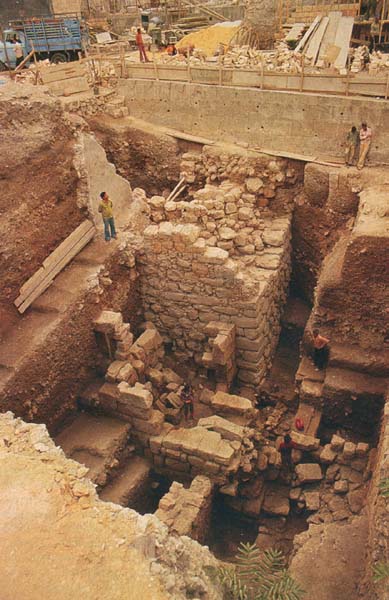
From the Broad Wall it is less than 100 yards north along Plugat HaKotel Road to a defensive tower built of the same type of hard, uneven stones as the Broad Wall. Avigad came upon this tower in 1980 when the opportunity to dig suddenly occurred after a particularly severe winter; heavy snow accumulations collapsed the roof of a house, thus allowing archaeological explorations.
For some time Avigad had wanted to probe along the northern defense line erected by the Hasmoneans, the Jewish dynasty that ruled Jerusalem in the second century B.C.E. Not far from the collapsed house, segments of this northern line had been previously uncovered.
Avigad proceeded to dig a 50-foot-deep pit where the collapsed house had stood. Loose earth threatened to cave in as the excavators dug down to reach bedrock. Avigad was pleased, but not surprised, to find the remains of a defense tower, 30 feet square with walls about 10 feet thick, made of typical Hasmonean ashlarsh with roughly raised bosses surrounded by smooth margins.
To the delight of the archaeological team, abutting the Hasmonean tower was another massive structure—a much earlier Israelite tower! The full height of this tower is not known, but 27 feet have survived above ground in an excellent state of preservation. As the archaeologists cleared the dirt at the foot of the Israelite tower, in an area outside this ancient city wall, they came upon a layer of charred wood, ashes and soot. In the ashes were five arrowheads, four Israelite (flat iron ones) and a Scythian bronze triple-winged 028arrowhead, the type used in the sixth century B.C.E. by Babylonians and other northern peoples. Here was poignant evidence of the devastating attack by Nebuchadnezzar, king of Babylon, who “burnt the house of the Lord, and the king’s house and all the houses of Jerusalem, even every great man’s house, burnt he with fire” (2 Kings 25:9). The soot and ashes are still there for the visitor to see, as are reproductions of the arrowheads, placed where the original ones fell some 2,500 years ago.
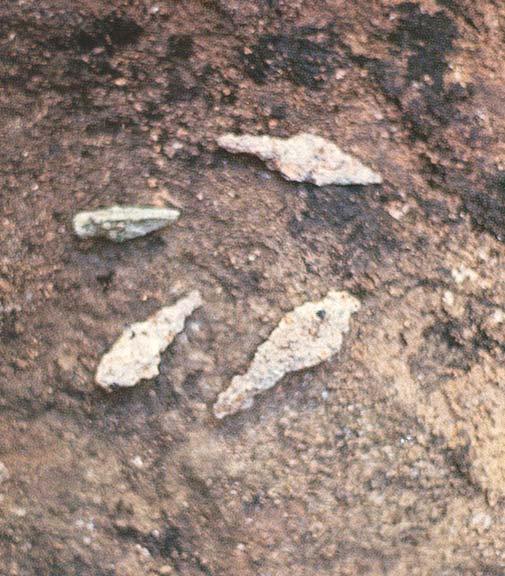
Near the modern staircase leading down to the base of the tower is a drawing based on the reliefs that decorated the throne room at Nineveh of Sennacherib, king of Assyria, depicting his siege of Lachish in 701 B.C.E. We see ramparts, battering rams and burning torches—a scene probably similar to what took place in Jerusalem at this very tower in 586 B.C.E. The ancient towers—one from the First Temple period, the other Hasmonean—are dramatically lit. A full-size Lucite model of a battering ram with a long beam—used to loosen fortification stones—stands against the First Temple Israelite tower. Extensive texts, in Hebrew and English, explain the significance of the Israelite and Hasmonean towers, and plans of the fortification systems from both periods indicate where other remains are located. Enlarged photographs illustrate the progress of the excavations and demonstrate better than words can the process of the search, the excitement of discovery.
The forced Jewish Exile in Babylonia lasted 50 years. In 538 B.C.E. the Persian king Cyrus, who had fallen heir to the Babylonian empire, proclaimed that Jews could leave Babylonia and return to their land. Some did return. But the excavators found no sign of occupation on the western hill from what archaeologists call the post-Exilic, or Persian, period. The Bible records that the returning exiles rebuilt the Temple, but it was so modest that priests, Levites and “old men that had seen the first [Temple] standing on its foundation, wept with a loud voice when this [Temple] was before their eyes” (Ezra 3:12). Nehemiah, the governor of Judea around 445 B.C.E., “built up the wall of Jerusalem” (Nehemiah 2:17)—most likely only the section near the City of David and the Temple Mount, but not the western hill.
In 332 B.C.E. Judea, and Jerusalem, became part of Alexander the Great’s empire, ushering in the Hellenistic period in the Near East. By 200 B.C.E. the Syrian Seleucids, heirs to part of Alexander’s empire, ruled Judea. In 167 B.C.E. the Seleucids desecrated the Second Temple and dedicated it to Olympic Zeus. This final provocative act fueled a Jewish uprising led by Judas Maccabee and his brothers. After they successfully expelled the Syrians, they founded the Hasmonean dynasty. When the Temple in Jerusalem was cleansed and rededicated (the event commemorated by lighting candles on the festival of Hanukkah), Jerusalem began to flourish once more. The city again spread onto the western hill, which was now encircled by a wall. In addition to the Hasmonean tower, which we have already described, segments of the Hasmonean wall were discovered at other locations on the western hill.
One hundred years after the successful revolt, Jewish independence ended and a new era began in Jerusalem. In 63 B.C.E., the Roman armies of Pompey captured Judea and Roman procurators became the rulers of the land. With Rome’s support, Herod the Great became king of Judea in 37 B.C.E. A cruel man who murdered his wife, Mariamne, her brother and his own two sons because of their Hasmonean ancestry, Herod was a master builder. From Caesarea to Jericho, from Samaria to Masada, the grandeur of his projects, his innovative construction methods and imaginative architecture still amaze us.
During the years when Nahman Avigad was excavating in the Jewish Quarter, his distinguished Hebrew University colleague Professor Benjamin Mazar carried out excavations south and southwest of the Temple Mount—the monumental platform enlarged by Herod to provide a grand site for the Temple of the Lord, which Herod rebuilt in an appropriately grand manner. These two great archaeologists worked opposite one another, across the valley, for 10 years, each uncovering a piece of the story of Jerusalem just before the Roman destruction in 70 C.E.
Even before Avigad discovered the extensive Herodian strata in the Jewish Quarter, the Herodian era was known for its monumental public buildings. But Avigad’s excavation revealed the opulent houses of the Herodian period and the elaborate lifestyle its upper-class occupants enjoyed.
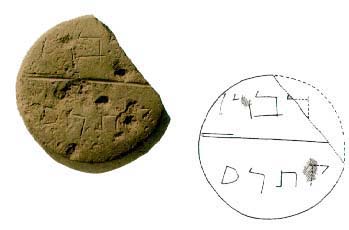
One of these houses preserved an especially poignant human story. A steep flight of steps leads down from Tiferet Yisrael Street to the basement of the Burnt House. This house probably belonged to the priestly family of Kathros, mentioned in the Babylonian Talmud—a stone weight bearing the name Kathros was found in the house. Even though the Burnt House tells of the end of the Herodian era and of the catastrophic events that occurred in Jerusalem in 70 C.E., we begin our exploration of Herodian 029Jerusalem there because an excellent 15-minute slide show introduces visitors to the period and to the drama of its archaeological discovery.
The Burnt House was uncovered during the first season of excavation, when, wrote Avigad, “we were still emotionally unprepared for the impressions and associations raised by the prospect laid bare before us.” Underneath a pile of fallen masonry darkened by fire was a thick layer of charred wood, ashes and soot, with fragments of pottery and stone vessels from the first century C.E. The latest coin found on the floor bore the legend “Year Four/of the Redemption of Zion,” or 69 C.E. In a corner, a spear still leaned against a wall. Then the excavators came upon the skeletal arm of a young woman, her hand still outstretched, clutching at a step.
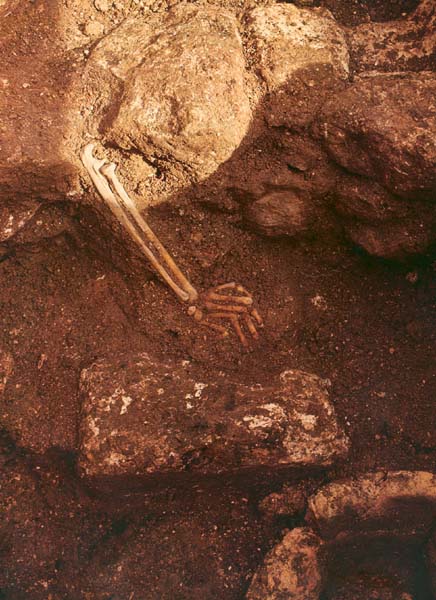
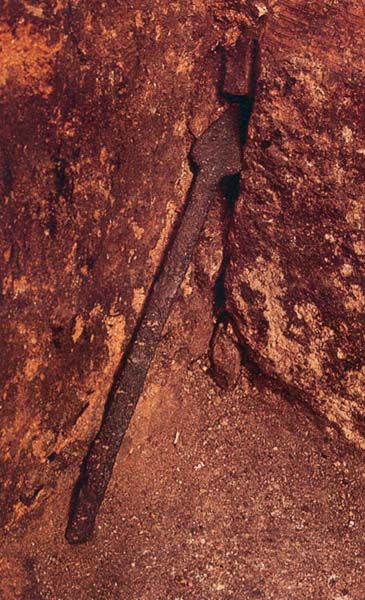
The Romans seized the Temple and burnt it on the 9th of Av (August), 70 C.E. The Upper City held out for another month, but finally the Romans prevailed. Josephus, who witnessed the events, describes how they “choked the alleys with corpses and deluged the whole city with blood … but when night fell the fire gained mastery, and the dawn of the eighth day of the month of Elul broke upon Jerusalem in flames—a city that had suffered such calamities.”5
When the archaeologists finished excavating the Burnt House, tons of sand were brought in to cover and protect the remains before construction of a modern residence above the site began. Once the building was complete, the sand was removed. The Burnt House was restored and opened to the public, 14 years after its discovery.
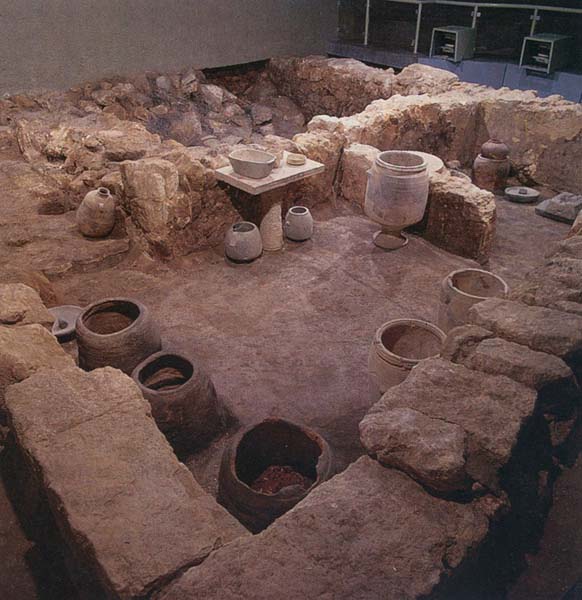
Several of the basement rooms that probably served as a workshop have been preserved at the Burnt House. Large storage jars and stone tables found at the site are displayed, as are the spear and various other artifacts, such as glass bottles, painted pottery vessels, coins and stone weights. The skeletal remains have been buried in accordance with Jewish law. One room is seen as it was on the day of destruction, the floor covered with ash, charred beams and broken vessels. A large drainage tunnel, built on bedrock, reminds us of the escape routes, as described by Josephus, used by the besieged Jews. A photomural shows the area as it was before excavations began.
From the Burnt House, one block to the south along Hakara’im Street, is “The Herodian Quarter—Wohl Archaeological Museum”i where six houses from the Upper City—covering 31,000 square feet—are preserved and restored (see plan). The entrance is just off Hurva Square, beneath Yeshivat HaKotel. The site was excavated from 1971 to 1974 after which the yeshiva was built over it. From 1985 to 1987 the site was prepared for the public under Avigad’s direction. It took six months just to remove the protective materials used by the excavators.
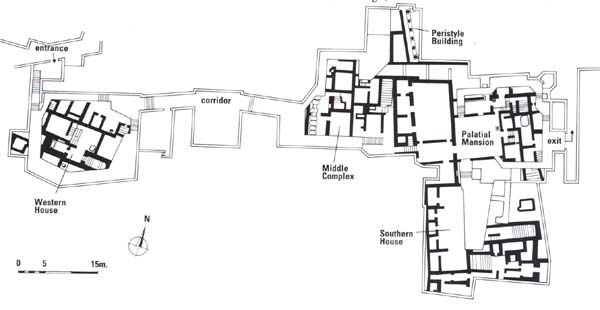
The six houses stood close together on terraces going down the eastern slope of the Upper City, facing the Temple Mount. Only two blind alleys separated them; presumably the streets were located on the periphery of the block of houses.
The remains of ground floors with living quarters and of basements with water installations and service areas were found in all the houses. Some may have had an additional story. Two of the larger houses were built around courtyards; in another a colonnade, called a peristyle, surrounded an open court.
The foundations of the houses rested on bedrock. The masonry was finely crafted and the walls were built of ashlars, their straight edges fitting firmly together. Impressions from plaster fragments that had fallen off interior stone walls indicate that some ashlars were only roughly finished before plaster was applied. The walls were decorated with frescoes depicting architectural or floral designs; on some walls wet plaster was modeled to resemble stone relief panels.
Avigad found nine black, red, yellow and white mosaics decorating the floors in the Herodian Quarter—the earliest example of mosaic art in Jerusalem. 031In the Hellenistic-Roman world, from which the mosaic technique was borrowed, representations of human and animal figures were common. But only floral and geometrical motifs appear in the Jerusalem mosaics, in faithful adherence to the then-current interpretation of the Second Commandment’s prohibition against graven images. Several of the mosaics contain a compass-drawn schematic rosette, a motif frequently seen in Jewish art, for example on ossuaries and sarcophagi. Today visitors can actually walk on the 2,000-year-old mosaic floors!
In a city where water is in short supply, the abundance of water installations in the houses of the Herodian Quarter is striking. Large plastered cisterns held rainwater collected from flat roofs. Each dwelling unit had a bathroom with a plastered bathtub and a vestibule paved in elegant mosaics. Special basins were probably used for washing feet.
A remarkably large number of ritual baths, or mikva’ot, were discovered. At least one mikveh—“a collection [of water]”—and often more, was found in every house in the Herodian Quarter. Most common among the many kinds of ritual baths was a rock-cut stepped pool, its lower part covered with a gray plaster. The pool was usually located underneath an unplastered vaulted ceiling made of ashlar blocks which did not touch the water. The building known as the Palatial Mansion, the largest house discovered in the Upper City, contained two especially large ritual baths; each had two doorways, located side by side, so that the bather could enter through one before purification and, once cleansed, leave through the other. At times the steps were separated down the middle by a low wall, creating one path for going down to the water, another for emerging.
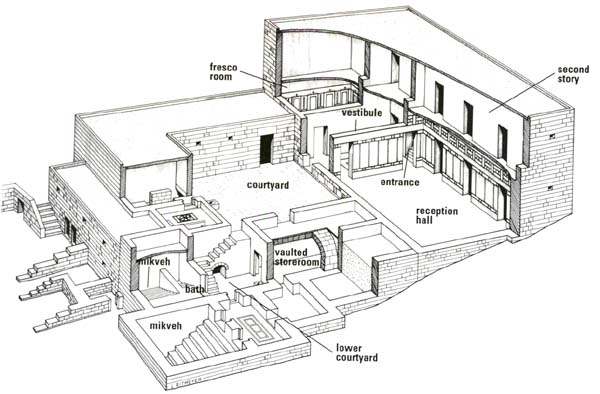
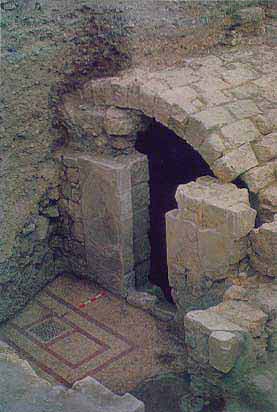
032
The large number of baths testify to the strict observance of the laws of ritual purity practiced by the residents of the Upper City during the Second Temple period. (These laws are recorded in the Mishnah,j which devotes ten chapters to the details of the mikveh) According to halakhah (Jewish religious law), immersion in a mikveh renders ritually clean a person who had come in contact with the dead or any other defiling object. Women must immerse themselves in it each month after menstruation, and after the birth of a child. (Today it is mainly women who use the mikveh, since after the destruction of the Temple the laws of ritual impurity relevant to men no longer apply. The mikveh is also used in the ceremony of conversion to Judaism.)
The law stipulates that a mikveh must be at least three cubits (about 4.5 feet) deep and hold no less than 40 seah (about 198 gallons) of spring water or rainwater that flows directly into the bath, without being transported by a vessel. Since this is not always practical, the immersion water can be purified by “touching” ritually pure water stored next to it in a special pool (otzar) and connected to the mikveh through a hole or pipe. Avigad, however, did not find any storage pools in the Herodian Quarter, and he speculates that it may have been possible to purify the water by some other means, as yet unknown. The mikva’ot were emptied by hand, from above, since religious law forbids a ritual bath to have a plugged hole because this might change the bath into a “vessel” or cause leakage, which would also invalidate it.
A walk through the Herodian Quarter begins at the Western House, close to the entrance of the museum. A sign informs us: “You have descended three meters [about 10 feet] below the level of the Jewish Quarter of today. You have gone back two thousand years in time, to the Upper City of Jerusalem in the Herodian period.” Newly constructed concrete piers support the yeshiva erected over the ancient remains and occasionally spoil our view. What can be seen is only a portion of what was uncovered; some remains had to be covered again. Others will never be seen because they were outside the limits of the excavation.
Although the excavations uncovered significant artifacts from the eighth century B.C.E., the time of the Judean monarchy, and from the second century B.C.E., the Hasmonean period, only one slice of time and space—dwellings from the Herodian period in the first century before and after the turn of the millennium—has been preserved.
At the Western House, elaborate bathing facilities are in the basement. Two ritual baths, a bathroom with a mosaic floor and mosaic-lined bathtub, and a vestibule ornamented with a red, yellow, black and white mosaic offer dramatic evidence of how the wealthy in Jerusalem attended to their ritual and bodily comforts.

From the Western House, a corridor leads to other houses in the underground museum. Showcases display objects that predate the Herodian period, discovered at this and other sites in the Jewish Quarter: 033pottery vessels, figurines and jar handles from the First Temple period—including some large-breasted fertility goddesses, a Canaanite tradition that persisted into Israelite times; eighth-century B.C.E. jar handles with seal impressions of a two-winged sun or a four-winged beetle, as well as inscriptions in ancient Hebrew script saying l’melech, “[belonging] to the king,” followed by the name of a city. These vessels with stamped handles are thought to have contained agricultural products collected as taxes during the time of Hezekiah, king of Judah (727–698 B.C.E.).
Displays of artifacts from the second century and the first half of the first century B.C.E. (the time of the Hasmoneans) include pottery jars, plates, oil lamps and jar handles stamped with the words Yehud (“Judah” in Aramaic) or Yrslm (Jerusalem) inscribed between the points of a five-pointed star.
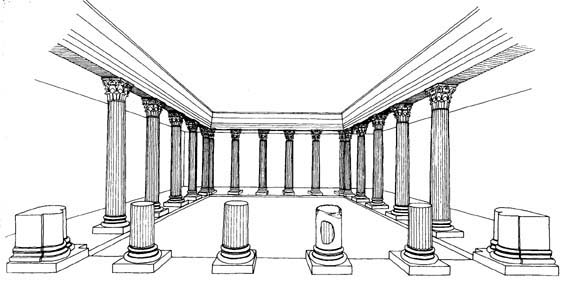
At the end of the corridor, the left-hand walkway leads to the Peristyle Building. Only a small part of this building could be excavated, but its restoration provides a glimpse of an architectural feature previously unknown in Jerusalem. A peristyle is an open courtyard surrounded by columns, a type of courtyard popular in luxurious Roman villas at Pompeii and used in the palaces built by Herod at Masada, at his winter retreat in Jericho and at his desert mountain fortress at Herodium. Uncovered in the Peristyle Building was a 31-foot row of six columns—two in situ each coated with fluted stucco. This row was no doubt parallel to another row on the opposite side of the courtyard, but that area was unavailable for excavation. A narrow, covered walkway surrounded the columns. Adjoining the courtyard, in a room found in bad repair, were fragments of elegant pavement. Now reconstructed, the floor consists of hexagonal white tiles surrounded by square black tiles and triangular red ones, laid with a paving technique popular in Rome at that time called opus sectile. In Israel, such paving appears elsewhere only in Herod’s palaces.
Returning to the fork in the corridor brings us first to an exhibit of finds from the Herodian Quarter, finds that evoke both opulence and superb craftsmanship—stone vessels, including bowls, goblets, cups and lids; fragments of stone tables; two limestone sundials marked with 12 radial lines; delicate painted pottery bowls decorated with red, brown and black floral designs; a bronze animal paw that fit over the end of a wooden table leg; and a graffito of a menorah, or seven-branched candelabrum, incised in plaster (a copy of the original now on display at the Israel Museum). This earliest depiction presumably closely matches the menorah that then stood in the Temple, just across the valley.

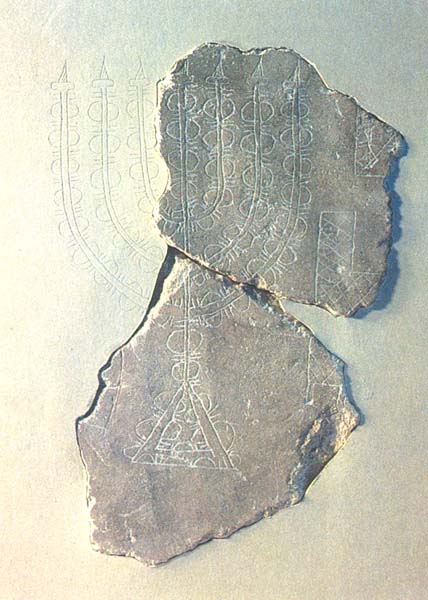
The abundance of stone vessels in these homes speaks both to the owners’ financial means and, 034probably, to their piety. Stone, according to the Mishnah, like glass, but unlike pottery, is not susceptible to ritual uncleanliness. It was clearly desirable to possess vessels that could not be contaminated, and it seems, from their many stone vessels, that this was the privilege of the wealthy citizens of Jerusalem’s Upper City in the days before the Temple was destroyed.
Several elegant glass vessels were unearthed in one large home, including a pitcher (now at the Israel Museum) damaged by fire, but still bearing the Greek inscription “Ennion made it.” Ennion was a famous glassmaker of the first century C.E., who probably worked in the Mediterranean coastal city of Sidon. Only three such vessels with his signature were ever found.
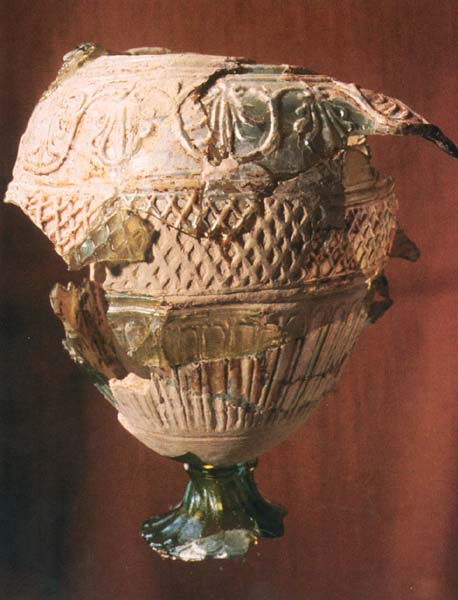
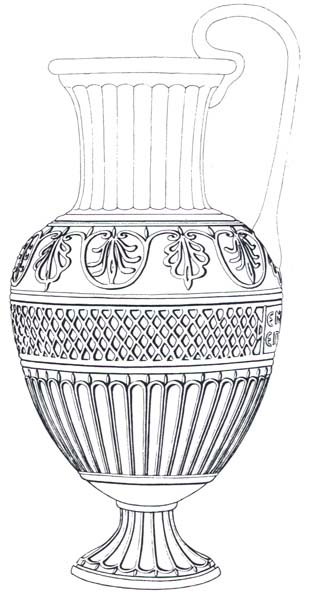

The Middle Block of the restoration contains several rooms that apparently belonged to two different houses. They were partially disturbed by later Byzantine construction. One spacious room has an intricate 035mosaic floor with a central panel of interlocking swastikas framed by a wave-crest pattern. The room’s furniture is grouped in accordance with a contemporaneous depiction on a table fragment. Two heavy, lathe-turned stone jars, more than 2 feet tall, stand beneath a stone pedestal table. A large stone tray and several small stone tables supported by three modern wooden legs are nearby.
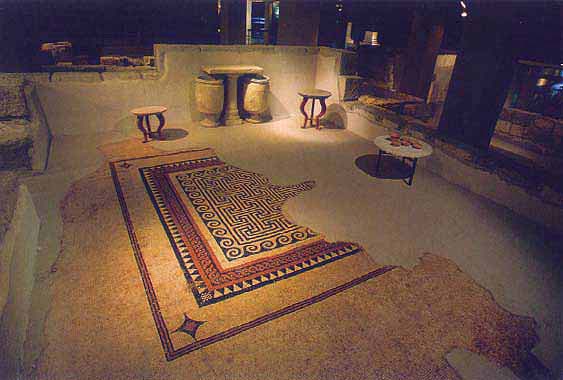
By far the largest, most impressive and best-preserved dwelling in the Herodian Quarter is the two-story Palatial Mansion. Covering an area of over 2,000 square feet, it is built around a spacious courtyard. Its basement contains cisterns, a storeroom and several ritual baths, one—the largest found in the whole area—is covered by an almost intact vaulted roof. On the ground floor are the living quarters, including a large, 33- by 2 l-foot hall with part of its northern wall preserved to a height of more than 11 feet.
The Palatial Mansion is a showcase for Herodian building techniques and interior decoration. In the entry hall, an exposed course of ashlars in an interior wall displays fine masonry work. Sealed beneath the entry’s elaborate mosaic floor, featuring a central multipetalled rosette and pomegranates in the four corners, was a coin dating from the third year of Herod’s reign, 34 B.C.E. This find gives us the probable date of the building’s construction. Here we also see the charred remains of cypress ceiling beams that collapsed in the fierce conflagration that destroyed Jerusalem in 70 C.E. South of the entrance, a large preserved wall fresco is painted in wide panels with borders of architectural motifs in red and yellow. The walls of the large hall are covered with thick white stucco incised to resemble courses of finely bossed ashlars and wide panels. In a room adjoining the large hall are traces of redecorating: underneath a layer of white stucco is a fresco of fluted columns and a frieze. Several of the most luxurious items found in the Herodian Quarter—the sundials and Ennion’s glass pitcher—came from this mansion. Recalling the unusual number of ritual baths found here and that the nearby Burnt House most likely belonged to the Kathros priestly family, Professor Avigad tentatively suggests that the Palatial Mansion might have been the house of the high priest.
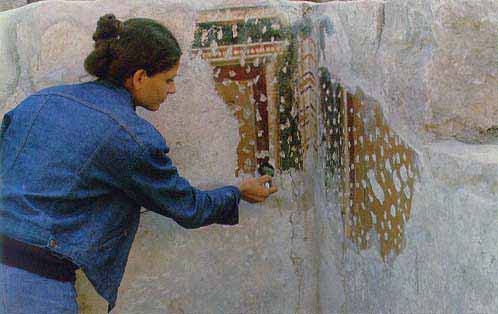
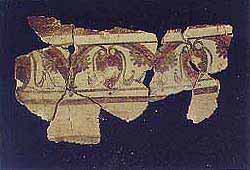
Immediately adjacent to this magnificent restoration is the Southern House, which was intentionally left without any repairs or restoration. Here only stubs of walls surrounding what appears to be a central courtyard and the vaulted ceiling of a basement storeroom help us appreciate the enormous restoration task undertaken by Avigad and his team.
When the Romans burned Jerusalem, three towers that protected Herod’s palace near today’s Jaffa Gate were left intact. The Romans left these, Josephus tells us, “to show future generations what a proud and mighty city had been humbled by the gallant sons of Rome.”6 After 70 C.E. the Roman Tenth Legion “Fretensis” probably camped by the ruins of Herod’s palace, near the Citadel, and in today’s Armenian Quarter. Less than 100 years later, the Jews again revolted against Rome. Led by Bar-Kokhba, the three-year uprising (132–135 C.E.) culminated in disaster—the expulsion by the Roman emperor Hadrian of all Jews from Jerusalem and the leveling of the city in order to construct a new Roman city—named Aelia Capitolina—over the ruins. To this day the Old City 036retains the quadrilateral shape and the network of streets modeled along the typical lines of a Roman colonial city bisected by a broad colonnaded north-to-south axis, the Cardo Maximus, and by an east-to-west thoroughfare, the Decumanus. The remains of one monumental triple gate from Hadrian’s time can be seen below today’s Damascus Gate; along the Via Dolorosa are the remains of another triple gate, commonly known as “Ecce Homo.”
Under Roman rule, Caesarea on the Mediterranean served as the capital of the province, not Aelia (Jerusalem). Only after 324 C.E., when Christianity became an officially permitted religion under the Roman emperor Constantine the Great, did Jerusalem, once again a major religious center, experience a period of expansion. The Church of the Holy Sepulchre, built over the traditional tomb of Jesus, and many other churches, monasteries and hospices date back to Constantine’s time. Two hundred years later, the emperor Justinian undertook major construction projects in Byzantine Jerusalem, some of which were recovered in the Jewish Quarter excavations.
A sixth-century mosaic map of the Holy Land, discovered in 1884 in a church in Madaba, Jordan, contains the earliest depiction of Jerusalem and shows clearly the course of the Cardo Maximus.
In the 1970s a contest was held for a design to rebuild the Street of the Jews, which ran along part of the presumed route of the Cardo represented on the Madaba map. Before the winners, architects Peter Bogod and Esther Niv-Krendel, began to dig foundations, Avigad and his team were called in to carry out a trial excavation on the supposed route of the Cardo. They were not surprised to discover large paving stones. The clearance of the route of the ancient street was a complex task that eventually took them through—and under—existing buildings until a 600-foot stretch of the Cardo was exposed. It was a splendid paved throughway, 60 feet wide, divided down its length by two colonnades. The open center was 40 feet wide, flanked by roofed porticoes for protection from the elements. In the southernmost section a row of chambers that had served as shops had been cut into the rock. A few column bases were found in situ, as well as column shafts, each made of a single stone, 038and three Corinthian capitals in Byzantine style. The reconstructed height of the pillars, with bases and capitals, is 16.6 feet.

It was assumed by all that the Cardo was part of the Roman city, Aelia Capitolina, and that the Byzantine coins and pottery found in the drains merely suggested the dates when the street was last used. The archaeologists were surprised to discover, however, that pottery found sealed beneath the pavement stones in the Jewish Quarter was Byzantine, and not Roman, thus establishing that at least this part of the street was built in the Byzantine period. There were scholars who disagreed: Professor Yoram Tsafrir of the Hebrew University felt that such a magnificent thoroughfare was typical of Roman architecture, and that Byzantine streets were always narrower.k Avigad argues that the architecture of the street was typically Byzantine, that the Byzantine pottery sealed beneath it is evidence for the Cardo’s date and that the street was built according to the 32-centimeter Byzantine foot, not the Roman one (29.6 centimeters). Also, since no Roman stratum was found anywhere in the Jewish Quarter, there would have been no reason to build such a magnificent road here. Therefore, it must be assumed that the Roman Cardo began at what is now the Damascus Gate at the northern end of the Cardo and stopped at the Decumanus, today’s David Street. It seems likely that 040when Justinian, in the sixth century C.E., built the magnificent Nea Church nearby (also excavated by Avigad), he extended the Cardo south, from its intersection with David Street to the Nea and beyond, to a gate in the southern city wall of that period.
The restoration of the Cardo, a joint effort of archaeologists, architects and the development company, is splendid. The southernmost end of the road is under the open sky, 20 feet lower than, and adjacent to, the Street of the Jews. Six columns stand on original paving stones. At one corner is an intact doorway of a Byzantine shop. The Cardo continues northward, underneath a two-story yeshiva. Texts, isometric views and a reproduction of the Madaba map along the route of the restored Cardo help orient the visitor. This section has ten reconstructed columns that are part of the western colonnade, now covered by a roof. We walk on segments of the original pavement and see parts of the original drainage system. The northernmost section of the Byzantine Cardo—remodeled by the Crusaders in the 12th century C.E. using ornamental columns, vaulted ceilings and arched doorways—is now lined with shops catering to tourists and pilgrims, as it was in the Byzantine and Crusader eras. Deep under the Cardo, seen through piers and down some steps, are remains of the fortifications we have already described from the First Temple period and from the Hasmonean period.
Working for more than two decades under the pressure of builders and prospective residents waiting to move into homes, Avigad excavated, studied, reconstructed and restored vital remnants from 2,000 years of Jerusalem’s history—from eighth-century B.C.E. artifacts to 13th-century Crusader remains.
Almost until the day of his death, on January 28, 1992, many visitors would recognize the aging professor as he moved about the Jewish Quarter with brisk energy, helping visitors to see and to understand. It was not unusual for people at an outdoor cafe to stop to shake Avigad’s hand and to say Todah rabbah, “Thank you very much.” Basically a shy man, Avigad cared intensely that people appreciated the importance of his discoveries. Once, when seeing the long line of visitors—Israeli and foreign—in front of the Burnt House, he said “This gives me satisfaction.” As one young man remarked to me after being shown the Herodian Quarter by Professor Avigad: “It was like being taken into the Holy of Holies by the high priest.”
For more on the Jewish Quarter Excavations see Discovering Jerusalem (Nashville, TN: Thomas Nelson, 1983) and The Herodian Quarter in Jerusalem—Wohl Archaeological Museum (Jerusalem: Keter Publishing House, P. 0. Box 7145, Jerusalem 91071, Israel [1989]), both by Nahman Avigad. The author wishes to express her indebtedness to these two 078publications, from which much of the material in this article has been taken, and to Professor Avigad himself for having reviewed the manuscript.
War—or rather two wars—made possible the current golden age of discovery in Jerusalem, at the City of David, at the Temple Mount and in the Old City’s Jewish Quarter. In 1948, during Israel’s War of Independence, the occupants of the Jewish Quarter surrendered to the Arab Legion following a long siege. Some houses had been damaged in battle, but most of the destruction occurred when the Arabs dynamited the Quarter’s institutions—synagogues, yeshivas (religious schools) and hospitals—after the surrender. For 19 years the Quarter stood empty and silent. Then, in June 1967, the Six-Day War brought the whole of […]
You have already read your free article for this month. Please join the BAS Library or become an All Access member of BAS to gain full access to this article and so much more.
Already a library member? Log in here.
Institution user? Log in with your IP address or Username
Footnotes
C.E. (Common Era) and B.C.E. (Before the Common Era), used by this author, are the alternate designations corresponding to A.D. and B.C. often used in scholarly literature.
The archaeological work was entrusted to the Institute of Archaeology at the Hebrew University in Jerusalem, the Department of Antiquities and Museums (now the Israel Antiquities Authority) of the Ministry of Education and Culture and the Israel Exploration Society. Benjamin Mazar was in charge of the Temple Mount excavations, Nahman Avigad worked in the Jewish Quarter and Yigal Shiloh headed the City of David excavations.
For earlier BAR articles on the Jerusalem excavations, see Nahman Avigad, “Jerusalem in Flames—The Burnt House Captures a Moment in Time,” BAR 09:06, and “Jerusalem Flourishing—A Craft Center for Stone, Pottery and Glass,” BAR 09:06.
For more on this model, see Rivka Gonen, “Visualizing First Temple Jerusalem,” BAR 15:03.
See Kathleen and Leen Ritmeyer, “Reconstructing Herod’s Temple Mount in Jerusalem,” BAR 15:06; Leen Ritmeyer, “Locating the Original Temple Mount,” BAR 18:02; and Joseph Patrich, “Reconstructing the Magnificent Temple Herod Built,” BR 04:05.
Dan Cole, “How Water Tunnels Worked,” BAR 06:02.
Magen Broshi, “Estimating the Population of Ancient Jerusalem,” BAR 04:02.
Maurice and Vivienne Wohl were the benefactors whose gift helped make possible the restoration of the Herodian Quarter and its display within a museum.
The Mishnah is the earliest codification of oral Jewish law, compiled in about 200 C.E., and is the basis of the Jerusalem and Babylonian Talmuds.
See “Is the Jerusalem Cardo Roman After All?” BAR 03:04; see also Nahman Avigad, letter, “The Jerusalem Cardo—Roman and Byzantine,” Queries & Comments, BAR 09:04.
Endnotes
Archaeologists were aware of their responsibilities from the very first days of the war. In The Battle for Jerusalem (New York: Popular Library, 1974), then General Motta Gur describes his astonishment when three civilians showed up early one morning at the brigade command, just as the troops were approaching the Rockefeller Museum. They were archaeologists Nahman Avigad, Joseph Aviram and Avraham Biran, concerned with the safety of the ancient artifacts at the museum. The three were allowed to accompany the soldiers into battle.
Crowded alleys where pedestrians and beasts of burden clashed were already a problem in 1890, when the Turkish municipal authorities banned camels from the Old City. Those large animals—and organic polluters—were allowed to “park” just outside the Citadel, and the goods they carried were transferred to the backs of small donkeys. To this day most goods are brought into the Old City by donkeys.
Ancient Near Eastern Texts Relating to the Old Testament, ed. James B. Pritchard (Princeton, NJ: Princeton Univ. Press, 1969), p. 288.
